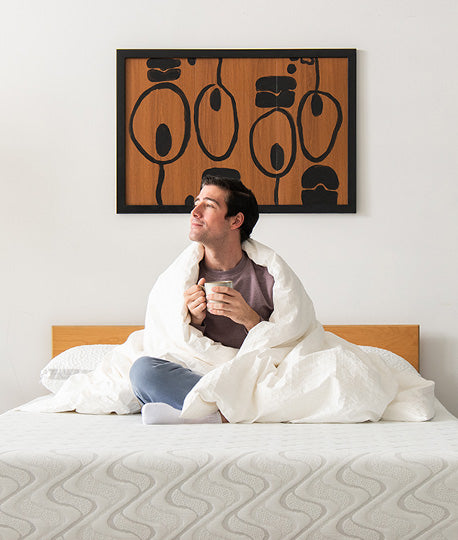How Plants In Your Bedroom Help You Sleep Better


When you think of organic bedding, what comes to mind? Most likely, it's a mattress, sheets, blanket, and comforter all made of natural fibers. And these things are essential. But it's the bedroom environment as a whole that provides the key to how to get a good night's sleep. Here, we'll explore a component of this environment that's about as organic as you could imagine: potted houseplants. As it turns out, there are powerful health benefits to having plants in your bedroom—which make them a wise (as well as beautiful!) component of your ideal sleeping environment. We'll begin by learning about the symbiotic relationship between plants and humans.
Plants and People: A Beautiful Symbiosis
Human respiration begins as we inhale, drawing in oxygen from the surrounding environment. Our body uses this oxygen—transferred via the bloodstream to all of our cells—to fuel cellular metabolism. It provides the muscles, bones, and organs of our body with the energy they need to function correctly. And when we exhale, we release carbon dioxide (a byproduct of cellular metabolism) back into the environment.
What's interesting is that photosynthesis—the process by which green plants use sunlight to create their food—is beautifully complementary to human respiration. How so? While humans exhale carbon dioxide, plants draw carbon dioxide from the environment and use it (in combination with water and sunlight) to produce what they need to grow. And during this process, oxygen is released back into the environment as a waste product.
In short: What plants, via photosynthesis, produce as a waste product (namely: oxygen) is what we humans need to inhale. And what humans, via respiration and cellular metabolism) produce as a waste product (namely: carbon dioxide) is what plants need to fuel photosynthesis. And this is just one of many reasons why it's beneficial to have an abundance of houseplants: They continually enhance the supply of oxygen in the indoor space of our home.
Fun Fact: Plants In Outer Space
But houseplants do a lot more than just keeping the air rich with oxygen. They also have powerful air-purifying capacities. According to research conducted by the U.S. National Aeronautics and Space Administration (NASA), indoor plants can pull toxic volatile organic compounds (VOCs) into the soil, where micro-organisms convert the VOCs into nourishment for the plants. Individual plants can remove a whopping 87% of airborne contaminants every 24 hours!
Now you might wonder: What on earth led NASA to conduct experiments on the VOC-scrubbing capacity of houseplants? And the answer lies not on earth, but instead on the moon—and in the Skylab 3 space-station that NASA scientists were constructing. The high-tech materials used to build the airtight space-station were off-gassing toxic fumes. And merely opening a window to vent fumes is not an option in outer space! So the scientists needed to figure out a way to purify the air--and indoor plants was the solution that proved to be most useful.
So here's a second reason why indoor plants (in your bedroom and elsewhere) are fantastic: they purify the air by removing a whole host of VOCs. And which plants are best at doing this? According to one compilation the top 20 air-purifying plants, it's the Boston fern that's the overall winner. And according to another study, it's the bromeliad that takes first place as the air-purifying champion.
What About Nighttime In The Bedroom?
A question you might have about plants in your bedroom is: What happens at night when photosynthesis is no longer occurring? Plants have their respiration process, which works similarly to how human respiration works: drawing in oxygen and releasing carbon dioxide back into the environment. Does this mean that plants, during the night, are competing with us for oxygen?
The answer to this question is twofold. The first thing to understand is that the amount of oxygen used at night by plants is minuscule, in comparison to the amount of oxygen they produce during the day. On average, houseplants produce ten times as much oxygen during the day (via photosynthesis) as they use at night. So the net effect of having plants in your bedroom is always positive, in terms of their oxygen contribution.
And secondly, some plant species emit oxygen throughout the night as well as the day. This unique quality makes these plants particularly excellent choices to keep in your bedroom, since they will continue to increase the oxygen level in the room, 24/7:
- orchids
- succulents
- snake plants
- bromeliads
In summary: All houseplants increase the amount of oxygen in indoor spaces, and all houseplants help to purify the air. And certain types of houseplants (those listed above) continue to emit oxygen even at nighttime--making them especially excellent to keep in our bedrooms.
Healing Scents: Houseplants As Aromatherapy
Perhaps you've used essential oils for their aromatherapy benefits: for their mood-enhancing, mind-transforming qualities. And there are ample scientific studies that validate the therapeutic use of scents to create psychological harmony. Smells process through our limbic system, which is deeply involved in memory, motivation, and emotional experience. This is why they can be so powerful in transforming our mental-emotional landscape.
Orange oil, for instance, is often used to alleviate anxiety and depression. The scent of lavender can create feelings of calm and ease. Jasmine is used for alleviating depression, and also as an aphrodisiac (enhancing feelings of love and sensuality).
But it's not only essential oils that produce aromatherapy benefits. Certain houseplants that release scents into the air can have the same effect of shifting our mood in a positive direction. While plants such as this are great to have anywhere in your home, they may be especially beneficial in your bedroom—where they can ferry you off into the sweetest of dreams via their heavenly healing scents. We've already mentioned orange, jasmine, and lavender, all of which act as fragrant indoor plants. Others to consider, for their aromatherapy benefits in your bedroom, include:
- lily
- geranium
- Marino blue heliotrope
- spearmint
- Corsican mint
- lemon balm
- Crown Jewel gardenia
- eucalyptus
- rosemary
Choose a plant whose fragrance makes your heart sing, and experiment with keeping it in your bedroom. The chances are good that your sleep will become more deeply nourishing, and your dreams even more inspiring.
Questions or comments? Feel free to contact us. We'd love to support you in creating the perfect sleeping environment.




